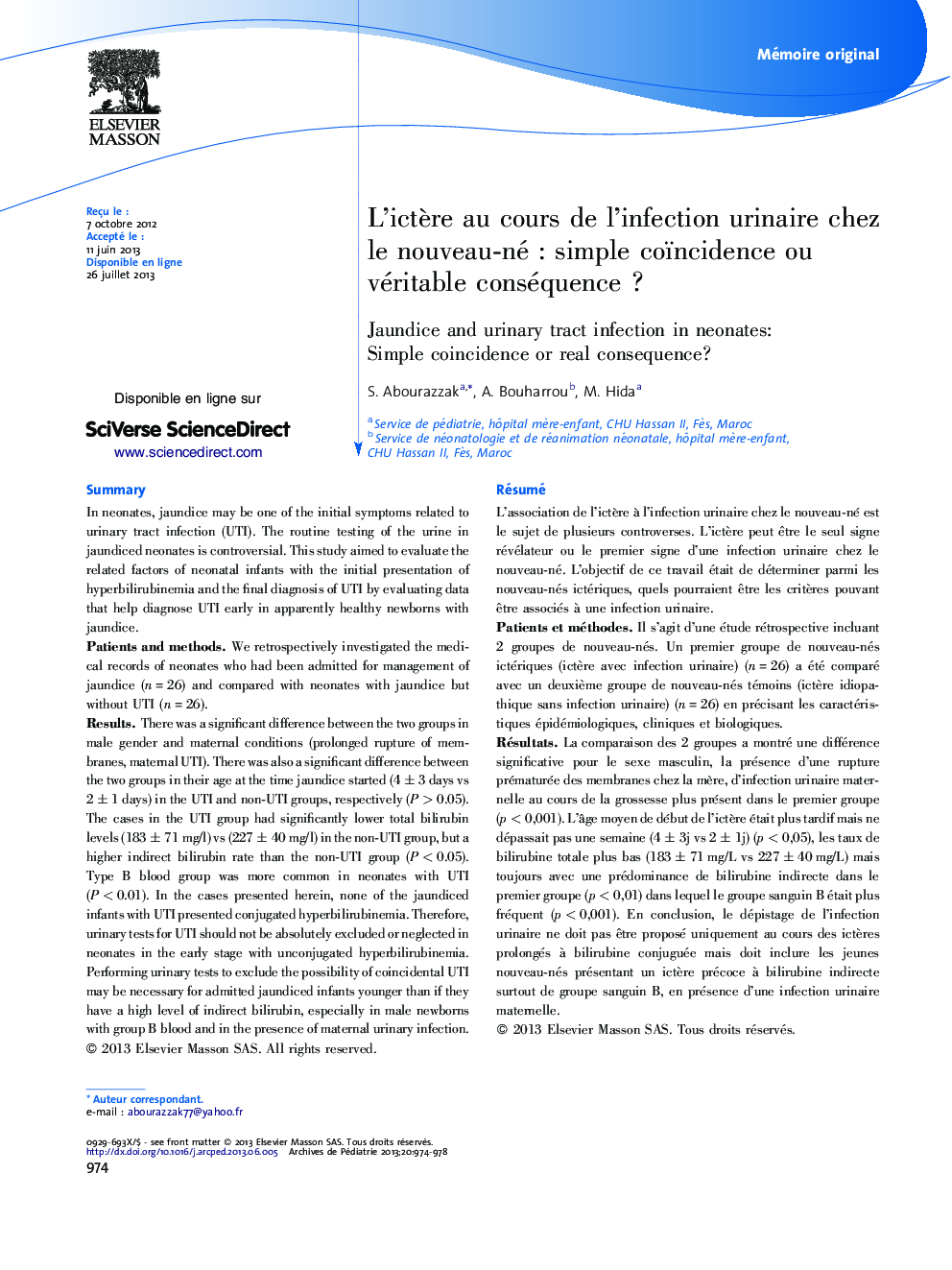| Article ID | Journal | Published Year | Pages | File Type |
|---|---|---|---|---|
| 4146725 | Archives de Pédiatrie | 2013 | 5 Pages |
RésuméL’association de l’ictère à l’infection urinaire chez le nouveau-né est le sujet de plusieurs controverses. L’ictère peut être le seul signe révélateur ou le premier signe d’une infection urinaire chez le nouveau-né. L’objectif de ce travail était de déterminer parmi les nouveau-nés ictériques, quels pourraient être les critères pouvant être associés à une infection urinaire.Patients et méthodesIl s’agit d’une étude rétrospective incluant 2 groupes de nouveau-nés. Un premier groupe de nouveau-nés ictériques (ictère avec infection urinaire) (n = 26) a été comparé avec un deuxième groupe de nouveau-nés témoins (ictère idiopathique sans infection urinaire) (n = 26) en précisant les caractéristiques épidémiologiques, cliniques et biologiques.RésultatsLa comparaison des 2 groupes a montré une différence significative pour le sexe masculin, la présence d’une rupture prématurée des membranes chez la mère, d’infection urinaire maternelle au cours de la grossesse plus présent dans le premier groupe (p < 0,001). L’âge moyen de début de l’ictère était plus tardif mais ne dépassait pas une semaine (4 ± 3j vs 2 ± 1j) (p < 0,05), les taux de bilirubine totale plus bas (183 ± 71 mg/L vs 227 ± 40 mg/L) mais toujours avec une prédominance de bilirubine indirecte dans le premier groupe (p < 0,01) dans lequel le groupe sanguin B était plus fréquent (p < 0,001). En conclusion, le dépistage de l’infection urinaire ne doit pas être proposé uniquement au cours des ictères prolongés à bilirubine conjuguée mais doit inclure les jeunes nouveau-nés présentant un ictère précoce à bilirubine indirecte surtout de groupe sanguin B, en présence d’une infection urinaire maternelle.
SummaryIn neonates, jaundice may be one of the initial symptoms related to urinary tract infection (UTI). The routine testing of the urine in jaundiced neonates is controversial. This study aimed to evaluate the related factors of neonatal infants with the initial presentation of hyperbilirubinemia and the final diagnosis of UTI by evaluating data that help diagnose UTI early in apparently healthy newborns with jaundice.Patients and methodsWe retrospectively investigated the medical records of neonates who had been admitted for management of jaundice (n = 26) and compared with neonates with jaundice but without UTI (n = 26).ResultsThere was a significant difference between the two groups in male gender and maternal conditions (prolonged rupture of membranes, maternal UTI). There was also a significant difference between the two groups in their age at the time jaundice started (4 ± 3 days vs 2 ± 1 days) in the UTI and non-UTI groups, respectively (P > 0.05). The cases in the UTI group had significantly lower total bilirubin levels (183 ± 71 mg/l) vs (227 ± 40 mg/l) in the non-UTI group, but a higher indirect bilirubin rate than the non-UTI group (P < 0.05). Type B blood group was more common in neonates with UTI (P < 0.01). In the cases presented herein, none of the jaundiced infants with UTI presented conjugated hyperbilirubinemia. Therefore, urinary tests for UTI should not be absolutely excluded or neglected in neonates in the early stage with unconjugated hyperbilirubinemia. Performing urinary tests to exclude the possibility of coincidental UTI may be necessary for admitted jaundiced infants younger than if they have a high level of indirect bilirubin, especially in male newborns with group B blood and in the presence of maternal urinary infection.
